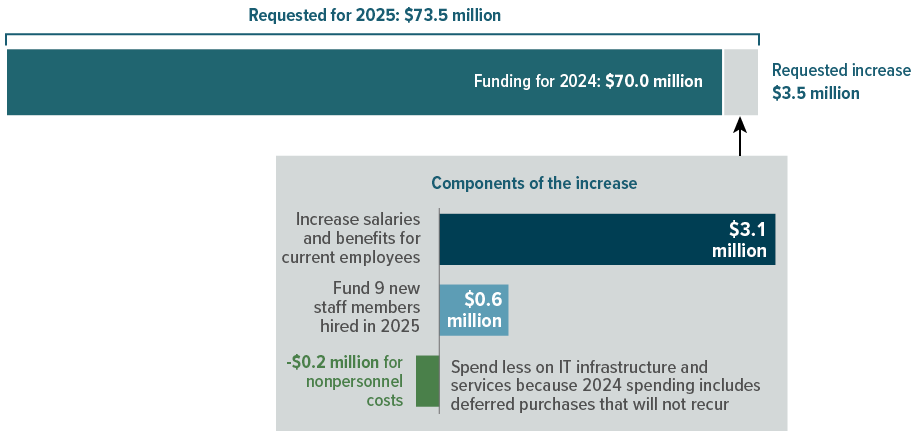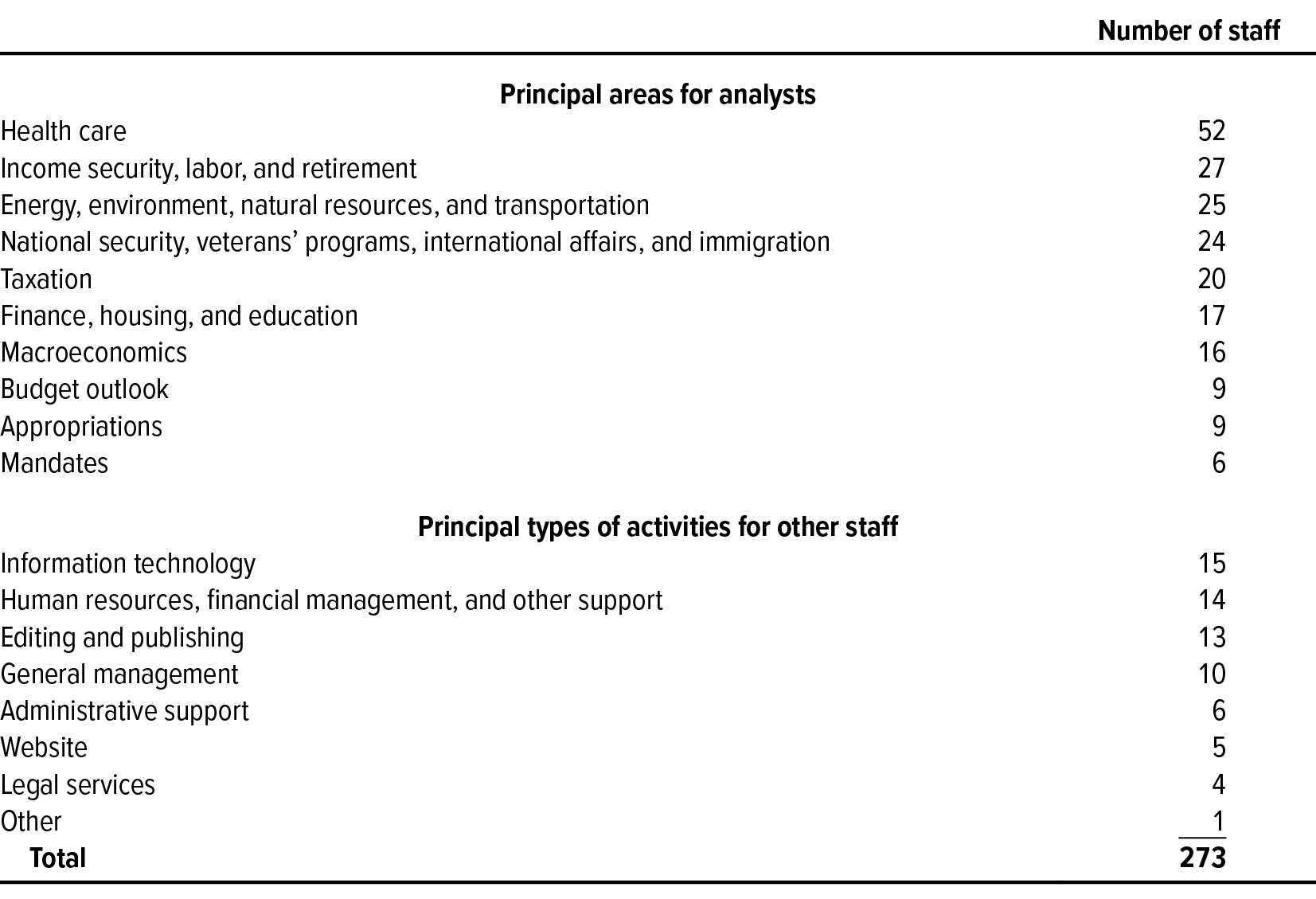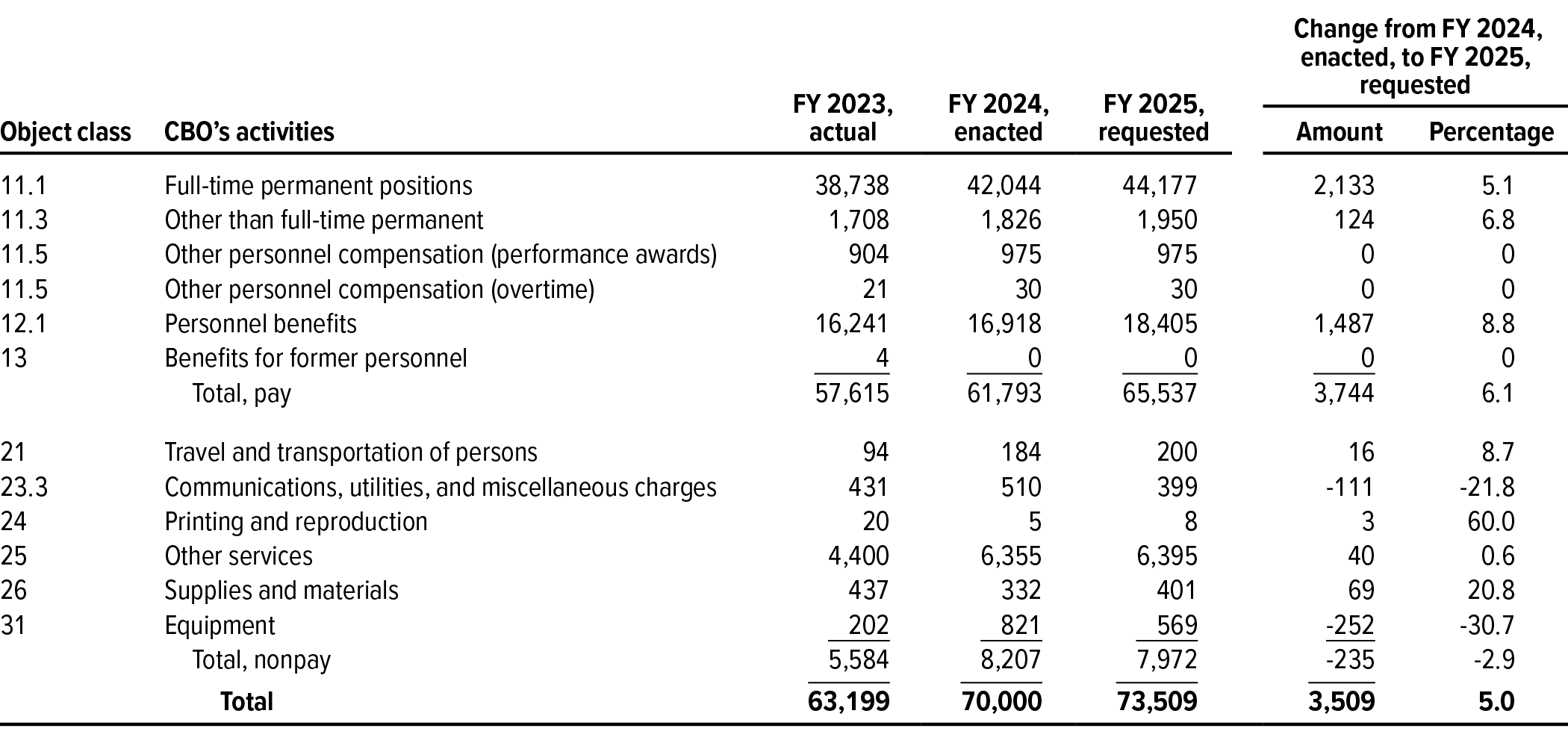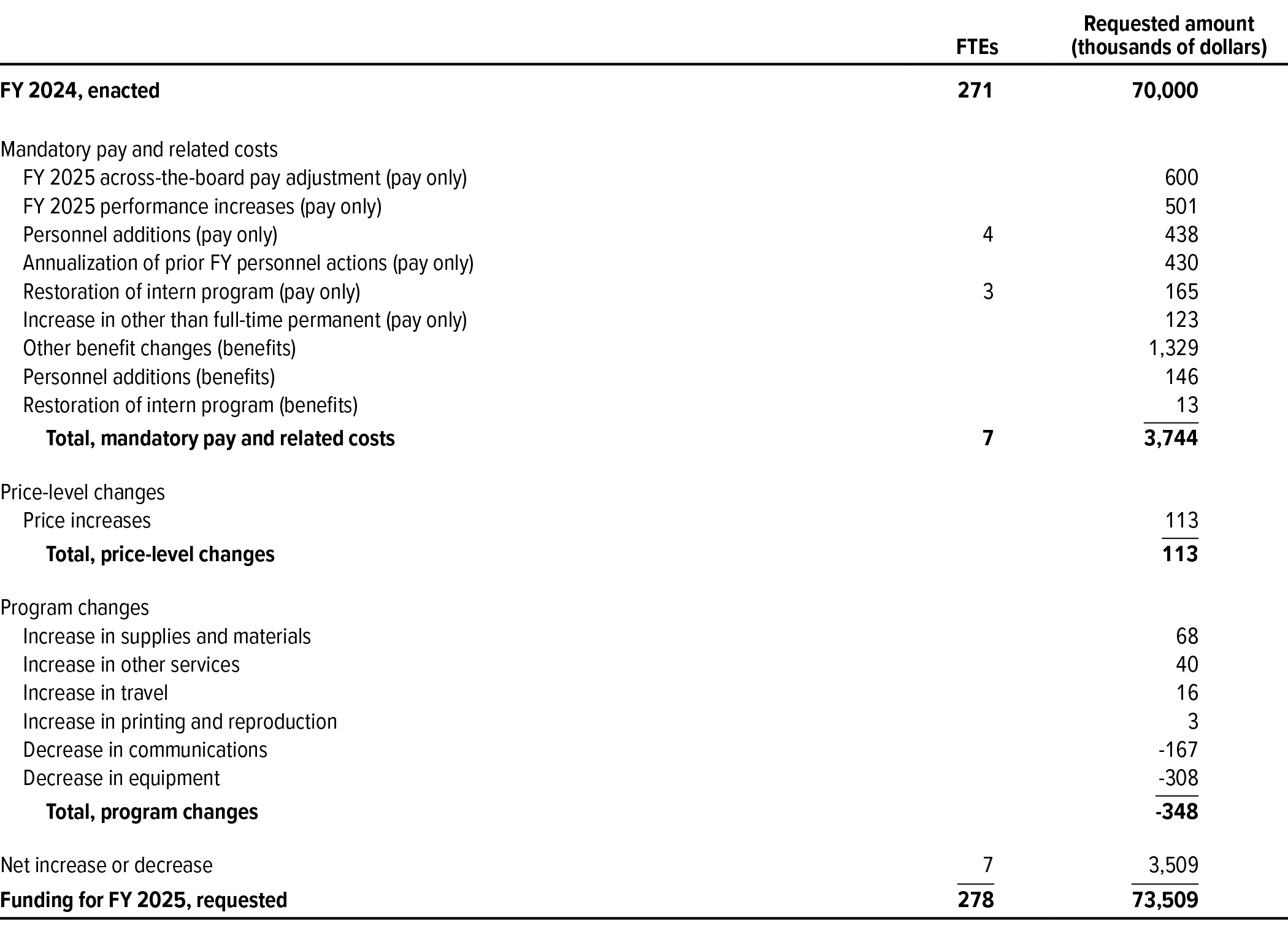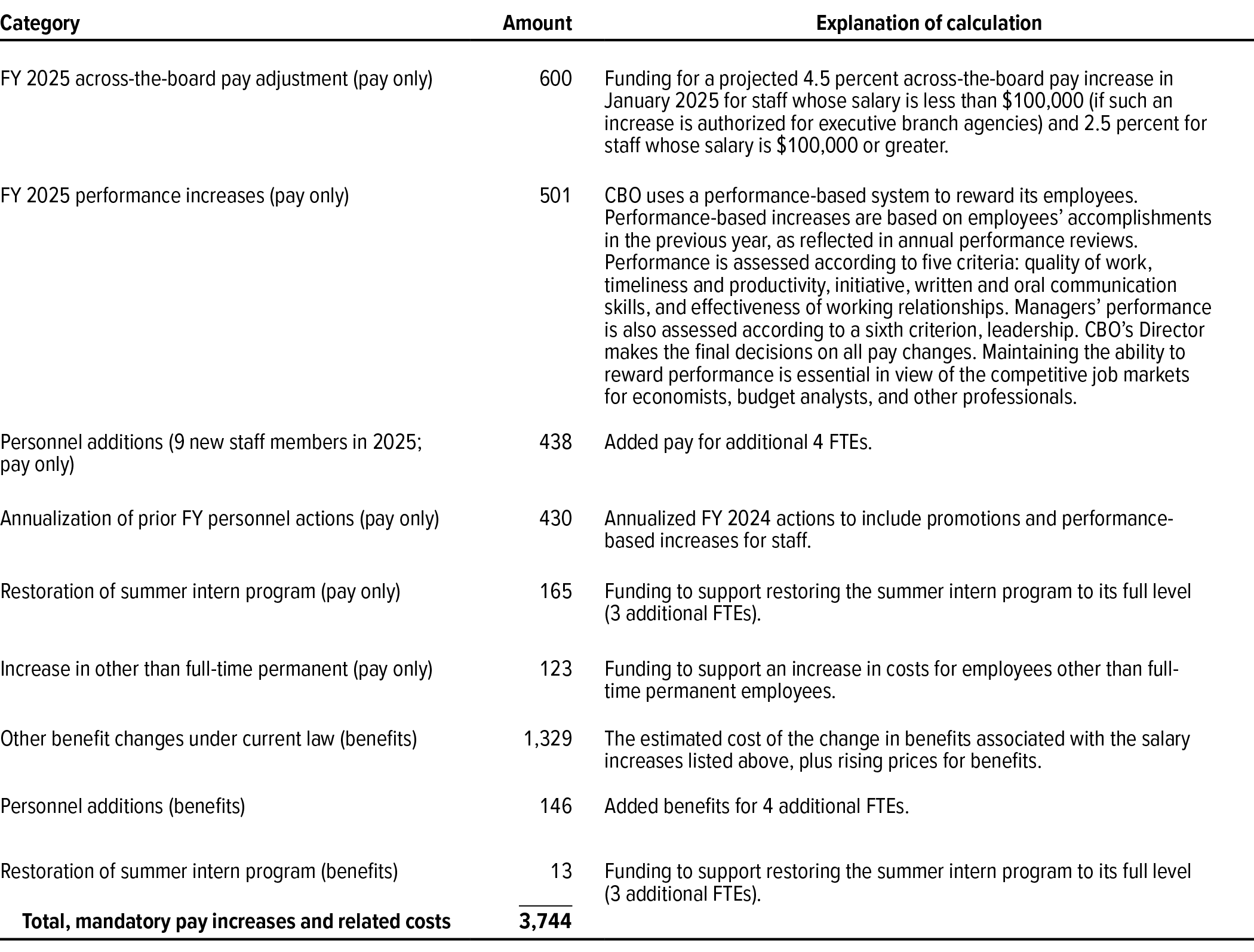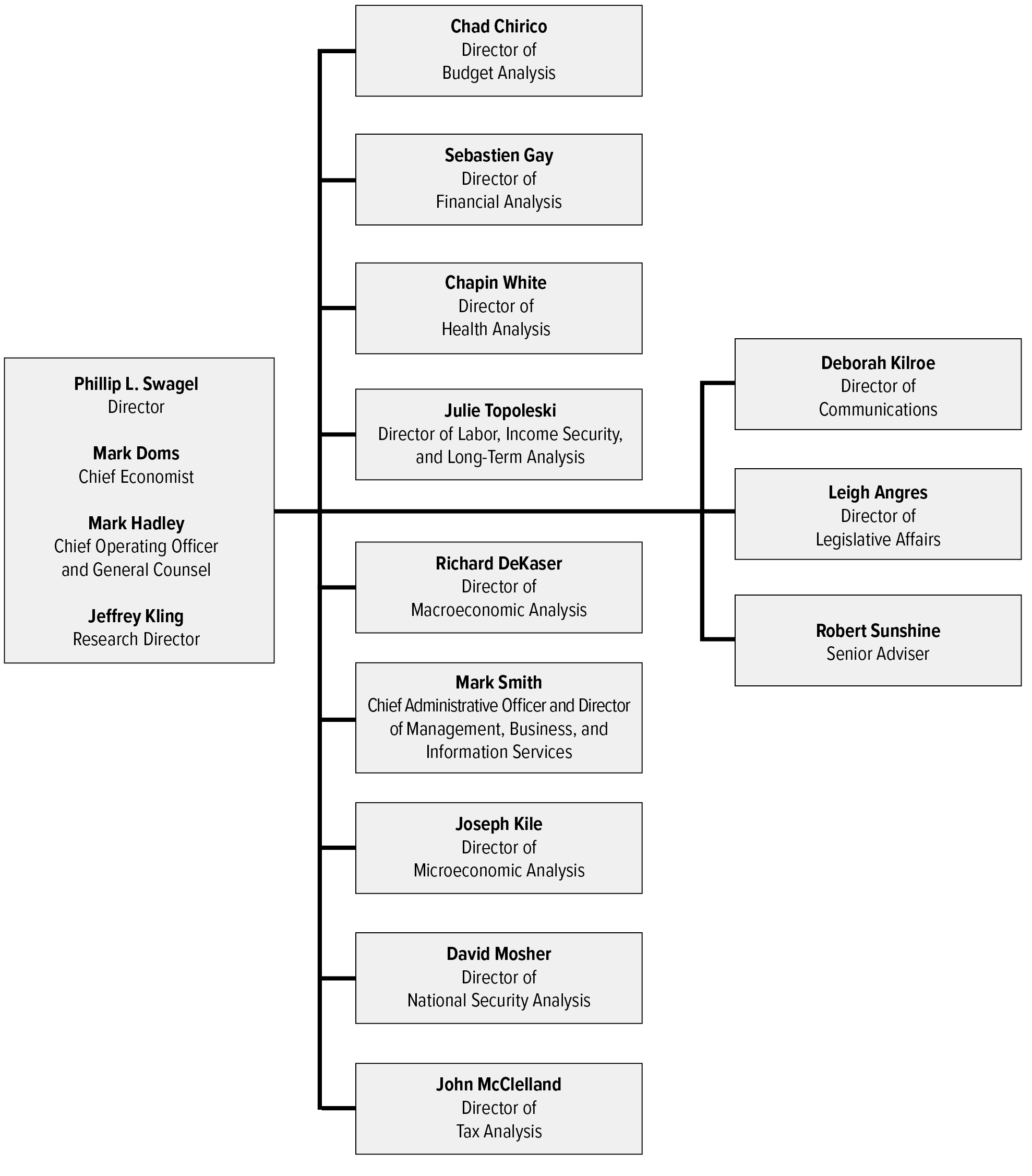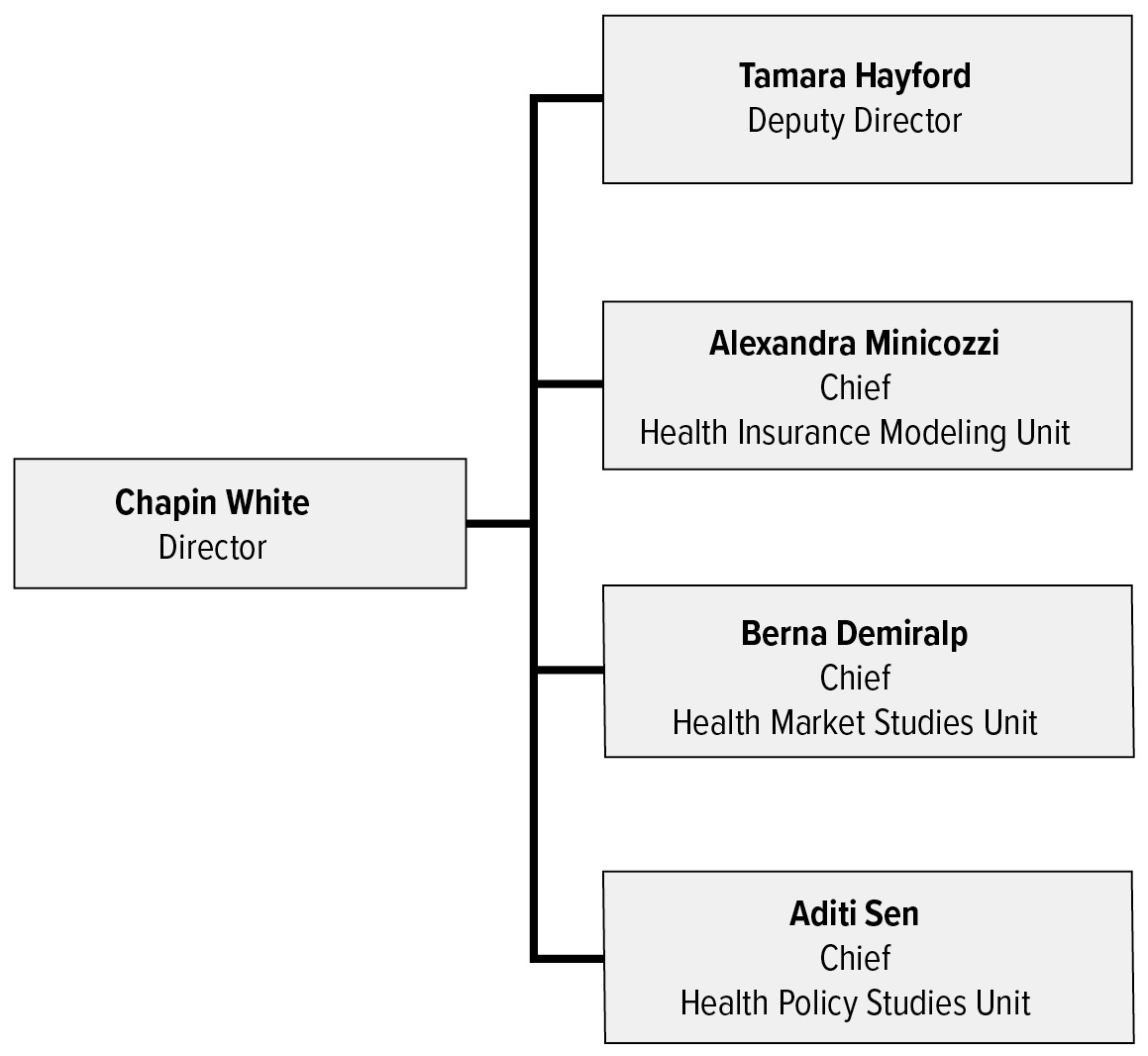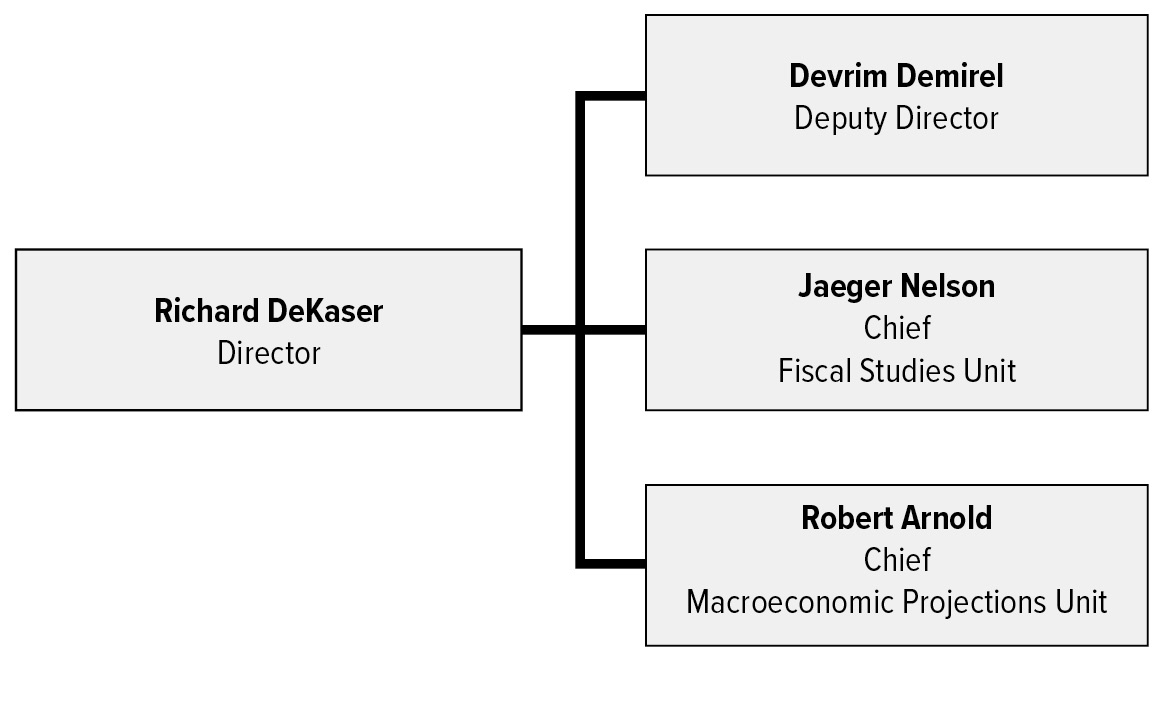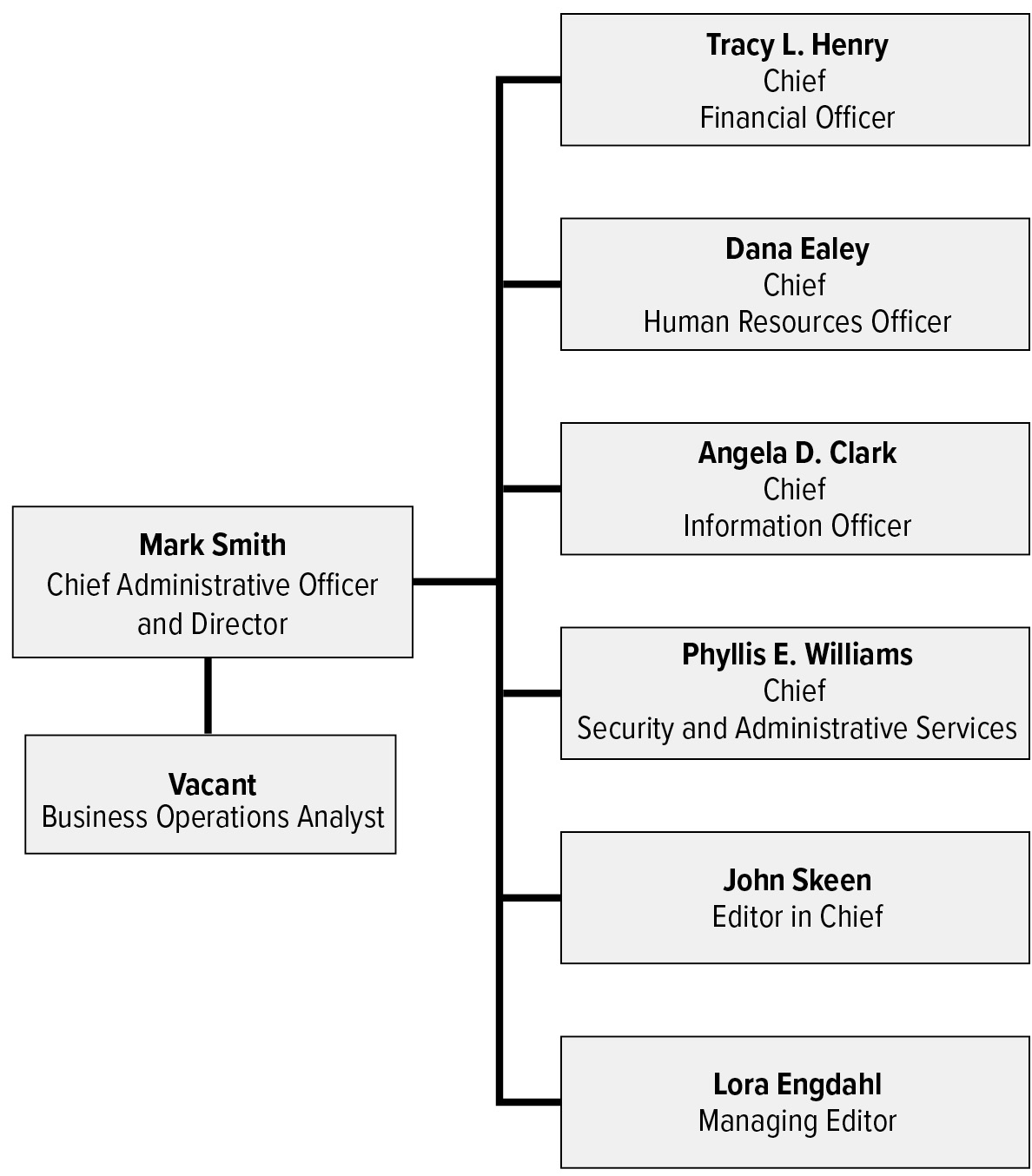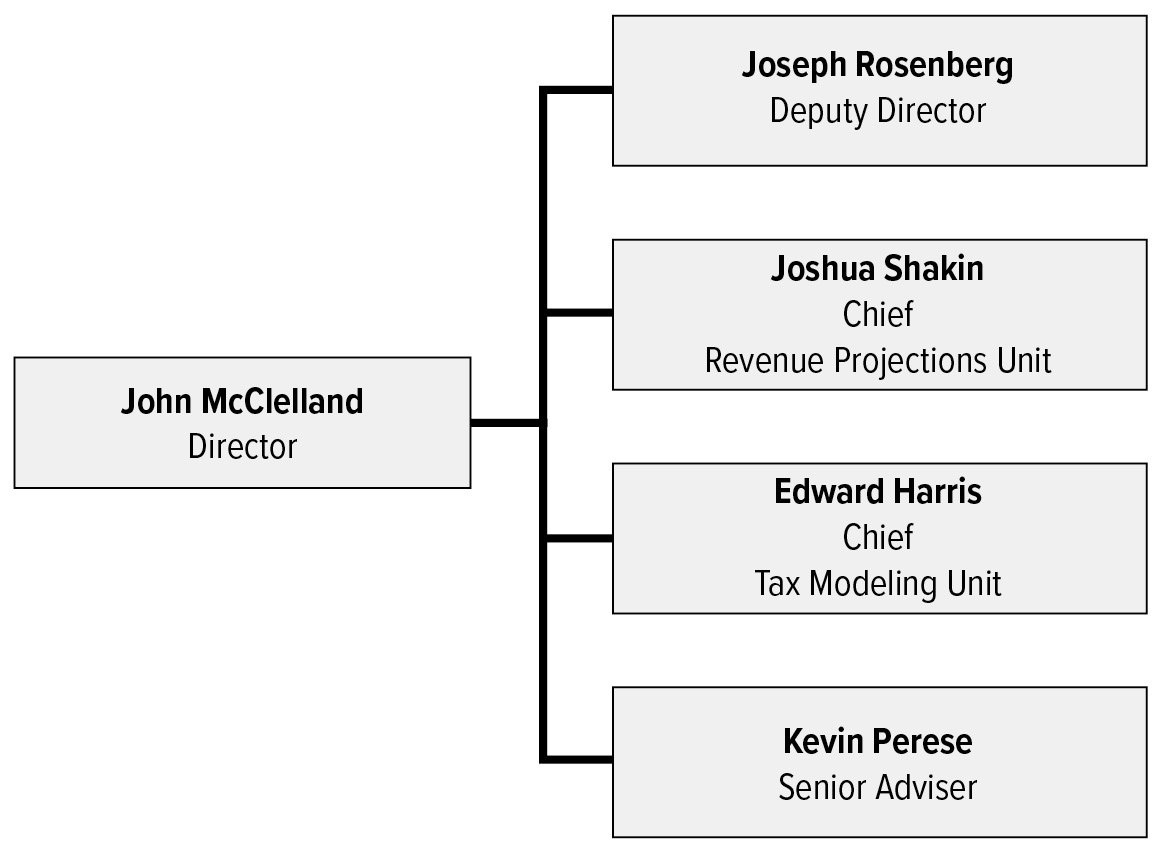Notes
Numbers in the text, tables, and figures may not add up to totals because of rounding.
CBO has corrected this report since its original publication. The correction is described at the end of the report.
The Congressional Budget Office’s Request for Appropriations for Fiscal Year 2025
The Congressional Budget Office requests appropriations of $73.5 million for fiscal year 2025: About 89 percent would be for pay and benefits; 7 percent would be for information technology (IT); and 4 percent would be for training, expert consultant services, office supplies, and other items. The request amounts to an increase of $3.5 million, or 5 percent, from the $70 million that CBO received for 2024. That increase would address increased costs brought about by inflation, sustain investments in IT infrastructure, and enable CBO to expand its staff in key areas.
The requested budget is based on strong interest in CBO’s work from the Congressional leadership, committees, and Members. On the legislative front this past year, CBO published about 675 cost estimates and devoted significant resources to analyzing the Fiscal Responsibility Act of 2023 (Public Law 118-5), the National Defense Authorization Act for Fiscal Year 2024 (P.L. 118-31), and H.R. 1, the Lower Energy Costs Act. The agency also fulfilled thousands of requests for technical assistance related to appropriation bills and the reauthorization of the farm bill. Providing estimates and assistance to the 119th Congress as it considers significant legislative initiatives is likely to require additional resources.
Operating under a continuing resolution—that is, at its fiscal year 2023 funding level—for half of fiscal year 2024 has been challenging. CBO postponed filling vacant positions and allowed the agency to shrink from 279 in late 2022 to 267 now. In addition, the agency cut back in myriad ways to save money.
CBO’s fiscal year 2024 funding will enable the agency to grow back to 276 positions by the end of the year, and the fiscal year 2025 request would support 285 employees—enough to satisfy its responsibilities under the Congressional Budget Act and enable it to be even more responsive in preparing cost estimates and providing technical assistance to Congressional committees.
Of the nine new staff members in 2025:
- Five would improve CBO’s capabilities to produce dynamic analysis (that is, determining how changes in fiscal policies would affect the economy), long-term estimates, analysis of defense weapons systems, and estimates of credit programs (like student loan programs);
- Two would enhance CBO’s responsiveness in producing cost estimates and providing technical assistance in the legislative process;
- One would enhance CBO’s IT security; and
- One would boost outreach to Congressional staff and the press.
CBO plans to use expert consultants more than it has in the past—enabling the agency to shift to the Congress’s key areas of focus more easily and to be more nimble in conducting facility management, work in IT, and financial management.
CBO’s requested increase is entirely for personnel expenses. In the request, total nonpersonnel expenses decline by about 3 percent because some of the agency’s spending for IT in 2024—including purchases of equipment, cybersecurity, and cloud services—is for deferred projects that will not recur in 2025.
CBO’s Budget Request and Its Consequences for Staffing and Output
In fiscal year 2025, CBO will continue its mission of providing objective, insightful, clearly presented, and timely budgetary and economic information to the Congress. The $73.5 million requested would be used mostly for personnel salaries and benefits. See Appendix A for detailed tables, and see Appendix B for details by object class.
Funding Request for Personnel Costs and Consequences for Staffing
CBO requests $65.5 million for salaries and benefits to support 285 employees by the end of fiscal year 2025, which equates to 278 full-time-equivalent positions for the year. That amount represents an increase in personnel costs of $3.7 million, or 6.1 percent, from the $61.8 million that was provided to CBO in fiscal year 2024.
Of the total requested amount:
- $47.1 million would cover salaries—an increase of $2.3 million, or 5 percent, from the amount provided in 2024. The requested increase would fund the hiring of nine new staff members in 2025. It would also provide for inflation adjustments and performance-based salary increases for current staff in 2025. Employees earning less than $100,000 would receive an across-the-board increase of 4.5 percent, whereas employees earning $100,000 or more (for whom more of their compensation is based on performance) would receive a 2.5 percent increase.
- $18.4 million would fund benefits—an increase of $1.5 million, or 8.8 percent, from the amount provided in 2024. The requested increase would cover growth in the cost of federal benefits and would fund benefits for the nine new staff members.
Funding Request for Nonpersonnel Costs
CBO requests $8.0 million for costs other than personnel costs. Those funds would cover current IT operations—such as cybersecurity, software and hardware maintenance, software development, communications, and purchases of commercial data and equipment—and would pay for training, expert consultant services, office supplies, travel, interagency agreements, facilities support, editorial support, financial management operations (including auditing of the agency’s financial statements), subscriptions to library services, and other items.
The requested amount for nonpersonnel costs is $0.2 million, or 2.9 percent, less than the amount in fiscal year 2024. The requested funding would, among other things, cover IT and other operational costs; continue to provide computing capabilities and maintenance for staff workstations that have been migrated to cloud-based systems; and improve CBO’s ability to detect, assess, and recover from cyberattacks. Much of the agency’s spending on cybersecurity is the cost of maintaining access to data that are essential to CBO’s analyses.
Consequences for Output
The requested funding would allow CBO to produce a great deal of valuable analysis for the Congress, including analysis in areas in which the agency anticipates additional legislative activity and oversight. It would also allow CBO to provide more technical assistance to committees and Members when they are crafting legislation and faster turnarounds when demand surges. In addition to providing major analytic products, CBO would be able to continue to produce other important material, such as presentations about CBO’s work, letters in response to Members’ questions, and blog posts.
CBO regularly consults with committees and the Congressional leadership to ensure that the agency’s resources are focused on the work that is of highest priority to the Congress. Nevertheless, the demands on the agency remain intense and strain its resources in many areas. Even with high productivity by a dedicated staff, CBO expects that it will not be able to produce as many estimates and other analyses as committees, leadership, and individual Members request.
CBO’s Role in Support of the Congress
CBO was established by the Congressional Budget Act of 1974 (the Budget Act) to provide information to support the Congressional budget process and help the Congress make effective budget and economic policy. CBO’s work follows processes specified in that law and subsequent laws or developed over time by the agency in concert with the House and Senate Budget Committees and the Congressional leadership. The agency’s chief responsibility under the Budget Act is to help the Budget Committees with the matters under their jurisdiction. CBO also supports other Congressional committees—particularly the Appropriations, Ways and Means, and Finance Committees, as the Budget Act requires—and the leadership of the House and Senate.
The agency is committed to providing information that is:
- Objective and insightful—representing the consensus of experts from around the country and the diversity of their views and incorporating the best new evidence as well as the lessons of experience;
- Timely—responding as quickly as possible to the needs of the Congress; and
- Clearly presented and explained—so that policymakers and analysts understand the basis for the agency’s findings and have the opportunity to question the analysis and methods used.
CBO strives to present the likely budgetary and economic consequences of proposals being considered by the Congress so that lawmakers can make informed policy choices. In keeping with CBO’s mandate to provide analysis that is objective and impartial, the agency makes no policy recommendations.
CBO employs analysts with many types of expertise, who support the Congress in collaboration with managers and support staff. At the beginning of January 2024, 273 positions at CBO were filled. Health care continues to be the area of analysis requiring the most staff. For key staffing changes over the past year, as well as CBO’s organization charts, see Appendix C.
Requested Information and Authorities
In this section, CBO provides information about its challenges in accessing federal data, requests the authority to provide a childcare benefit, and addresses requirements to report on recommendations by others.
CBO’s Access to Data
The House Committee on Appropriations directed CBO to report to the committees of jurisdiction on any challenges in accessing federal data and to identify whether the Congress can take any actions to ensure continuous and real-time access. CBO obtains from federal agencies a wide array of information, which it uses to produce baseline budget projections, economic projections, cost estimates, and reports.
CBO works collaboratively with agencies to obtain data through formal and informal means. The Budget Act provides CBO general authority to access data from a variety of sources. CBO also accesses data by using specific authority or by collaborating with other agencies. CBO currently has more than 20 active data-use agreements with other federal agencies. However, shifting legal and regulatory frameworks of federal agencies can delay, weaken, or cut off CBO’s access to information. The time spent negotiating and renewing agreements varies widely and is unpredictable, taking from a couple of weeks to over a year.
During 2024, CBO identified three challenges and actions the Congress can take to improve the agency’s access to federal data:
- Preserving access to student aid data. Without a change to section 6103 of the Internal Revenue Code, CBO will lose access to an important component of the agency’s models of the Federal Pell Grant Program and student loan programs. CBO currently receives from the Department of Education data on the income of student loan and Pell grant recipients. In the summer of 2024, the Education Department will begin receiving certain income information about student loan borrowers directly from the Internal Revenue Service (IRS), newly making the data federal tax information (FTI). CBO is seeking an amendment to section 6103 to allow the agency to continue to receive those data. CBO receives FTI for other purposes and is compliant with the IRS’s security requirements. CBO has been working with the House Committee on Ways and Means; the House Committee on Education and the Workforce; the Senate Committee on Finance; the Senate Committee on Health, Education, Labor, and Pensions; and the House and Senate Budget Committees regarding an amendment.
- Strengthening general authority under the Budget Act. CBO seeks to clarify and strengthen its general authority for accessing executive branch data under the Budget Act. The agency seeks an amendment to section 201(d) of the act to strike the parenthetical “(other than material the disclosure of which would be a violation of law).” That caveat risks undermining the broad data access that the Budget Act is intended to provide and is unnecessary when another statute more specifically governs CBO’s access to specific data. The caveat can also delay CBO’s access to data by requiring additional discussions with agencies, impairing the timeliness of CBO’s work. In February 2024, the House Budget Committee approved H.R. 7032, the Congressional Budget Office Data Sharing Act. Enacting the bill would remove the caveat and, instead, provide CBO access to executive branch data unless that access is specifically disallowed by a future law. The bill also includes a reference to section 203(e) to highlight CBO’s obligation to protect the restricted information it receives.
- Obtaining authority under the Privacy Act. CBO also seeks to clarify and strengthen its authority for accessing executive branch data through an amendment to the Privacy Act of 1974. In June 2023, the Senate passed S. 1549, and in February 2024, the House Committee on Oversight approved an identical bill, H.R. 7184, which would authorize the disclosure to CBO of information protected by the Privacy Act, providing the agency the same access that the Government Accountability Office has. In general, the Privacy Act prohibits executive branch agencies from disclosing certain records without the prior written consent of the people to whom the records pertain. There are currently 12 exceptions to that prohibition, and enacting S. 1549 or H.R. 7184 would add a 13th specifically for disclosures to CBO. The agency often requires the type of individually identifiable data the Privacy Act protects to prepare requested analyses and avoid relying on aggregations and statistics created by executive branch agencies. If granted access to such data, CBO would protect the information and not disclose it.
In addition to the items above, CBO is seeking authority for fiscal year 2025 (and would need to renew its request for any subsequent years) to accept gifts of property, including money and intangible property, or services to support the operation of the agency. Under current law, CBO often can obtain new data sets and tools from private entities by procuring them using appropriated funds or negotiating no-cost contracts. Gift authority would enable CBO to sometimes obtain such data and tools more quickly or without expense, as many legislative and executive agencies do. This authority would also enable CBO to accept donations for events such as those commemorating the agency’s 50th anniversary.
As the interests of the Congress change, CBO must develop the capacity to analyze new issues and policies. Consequently, the agency will need to obtain new sources of information and might require new specific authorities to do so. CBO will work with the committees of jurisdiction as new challenges arise.
Requested Authority for a Childcare Benefit
The Joint Explanatory Statement accompanying the Further Consolidated Appropriations Act, 2024, noted that each legislative branch agency may request authority to provide a childcare benefit in its fiscal year 2025 budget request. CBO requests the authority as follows:
Sec. ____ The Director of the Congressional Budget Office may expend funds appropriated in fiscal year 2025 and each fiscal year thereafter to reimburse employees of the Office for costs to improve the affordability of childcare if the Director determines that reimbursing such expenses is of sufficient benefit or value to the Office.
Included in CBO’s fiscal year 2025 budget request is $250,000 for the cost of those payments (embedded in various object classes for benefits). This benefit would enhance CBO’s ability to recruit and retain a talented and competitive workforce. Because of the agency’s size, individual reimbursement for childcare costs is the most cost-effective, feasible mechanism for providing a childcare benefit to its employees, making the cost more affordable.
Requirements to Report Recommendations by Others
The Good Accounting Obligation in Government Act requires agencies’ budget requests to report public recommendations made by the Government Accountability Office or by an office of inspector general. There are currently no such recommendations for CBO to report.
In addition, the Joint Explanatory Statement accompanying the Consolidated Appropriations Act, 2023, directed each legislative branch agency to provide in its annual budget justification a summary of all open oversight recommendations, to include the reasons that a recommendation remains open and a cost proposal for fully implementing each unresolved recommendation. CBO has no open oversight recommendations to report.
Highlights of CBO’s Work in 2023
In calendar year 2023, CBO continued to provide a significant amount of important analysis to the Congress. For a more comprehensive review of CBO’s work in 2023 than appears here, see Appendix D.
Analyzing Major Legislation
CBO provided technical assistance and estimates of budgetary effects at each stage of the legislative process for the Fiscal Responsibility Act of 2023 (P.L. 118-5), the National Defense Authorization Act for Fiscal Year 2024 (P.L. 118-31), and H.R. 1, the Lower Energy Costs Act—always with the goal of providing information when it was most useful to the Congress. CBO’s contributions related to those bills included the following:
- Technical assistance (including responses to hundreds of requests for preliminary estimates) to staff members of various House and Senate committees and in leadership offices as they developed legislative proposals,
- Cost estimates amounting to scores of pages of detailed information,
- Feedback on thousands of amendments before they were considered on the House or Senate floor, and
- Tables summarizing the bills’ budgetary effects.
To provide a sense of how extensive such analysis of major legislation can be, here are some details about CBO’s review of the National Defense Authorization Act for Fiscal Year 2024: CBO prepared five cost estimates and reviewed 3,601 amendments. Of those, 895 amendments were reviewed when the bill was being considered by the House Armed Services Committee, 1,841 (submitted by 380 Members of the House) were reviewed before the bill was considered on the House floor, and 865 (submitted by 97 Senators) were reviewed before consideration on the Senate floor.
Meeting Other Legislative Needs of the Congress
In 2023, CBO carried out much other work as well, often under tight time constraints. The agency fulfilled thousands of requests for technical assistance related to annual appropriation bills and the reauthorization of the farm bill. It responded to thousands of other requests for technical assistance (including providing information about the budgetary effects of proposed amendments to legislation), prepared hundreds of other cost estimates, reviewed close to 200 bills considered under suspension of the rules in the House, and compiled about 100 scorekeeping tabulations.
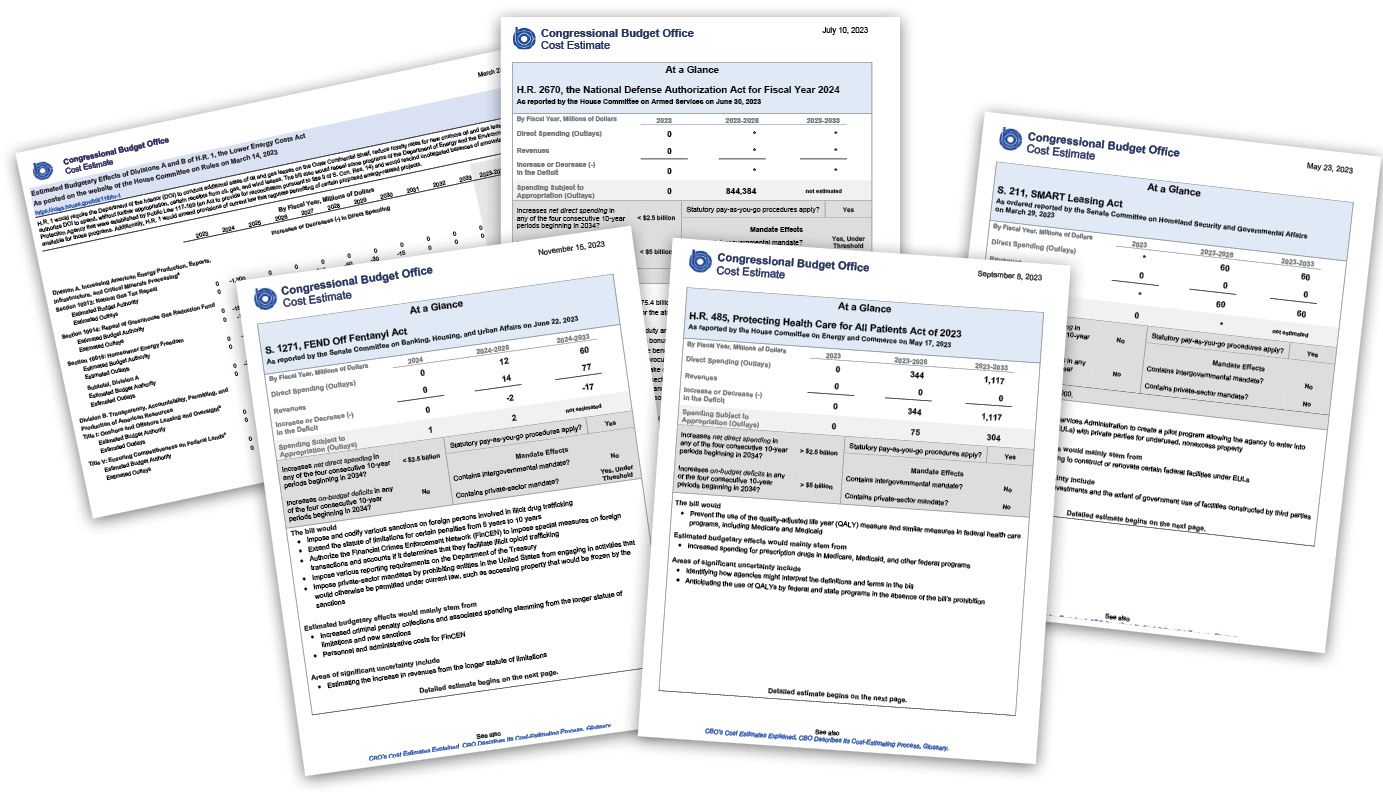
Performing Budgetary and Economic Analysis
CBO released a set of budget and economic projections in February 2023. The agency updated its budget projections in May, its annual long-term budget projections in June, and its economic projections in July and December. CBO’s baseline budget and economic projections serve as a benchmark for many of the analytic reports, working papers, and other documents published by the agency.
Last year, other publications examined a variety of topics, including military compensation, flood damage and federally backed mortgages in a changing climate, federal subsidies for health insurance, the long-term fiscal effects of Medicaid spending on children, and the distribution of household income. CBO aimed to promote a thorough understanding of those topics by clearly presenting its analyses and explaining the basis for them.
All told, CBO prepared 102 reports, working papers, testimonies, slide decks, interactive tools, and infographics, as well as other material, such as presentations, letters to Members, and blog posts.
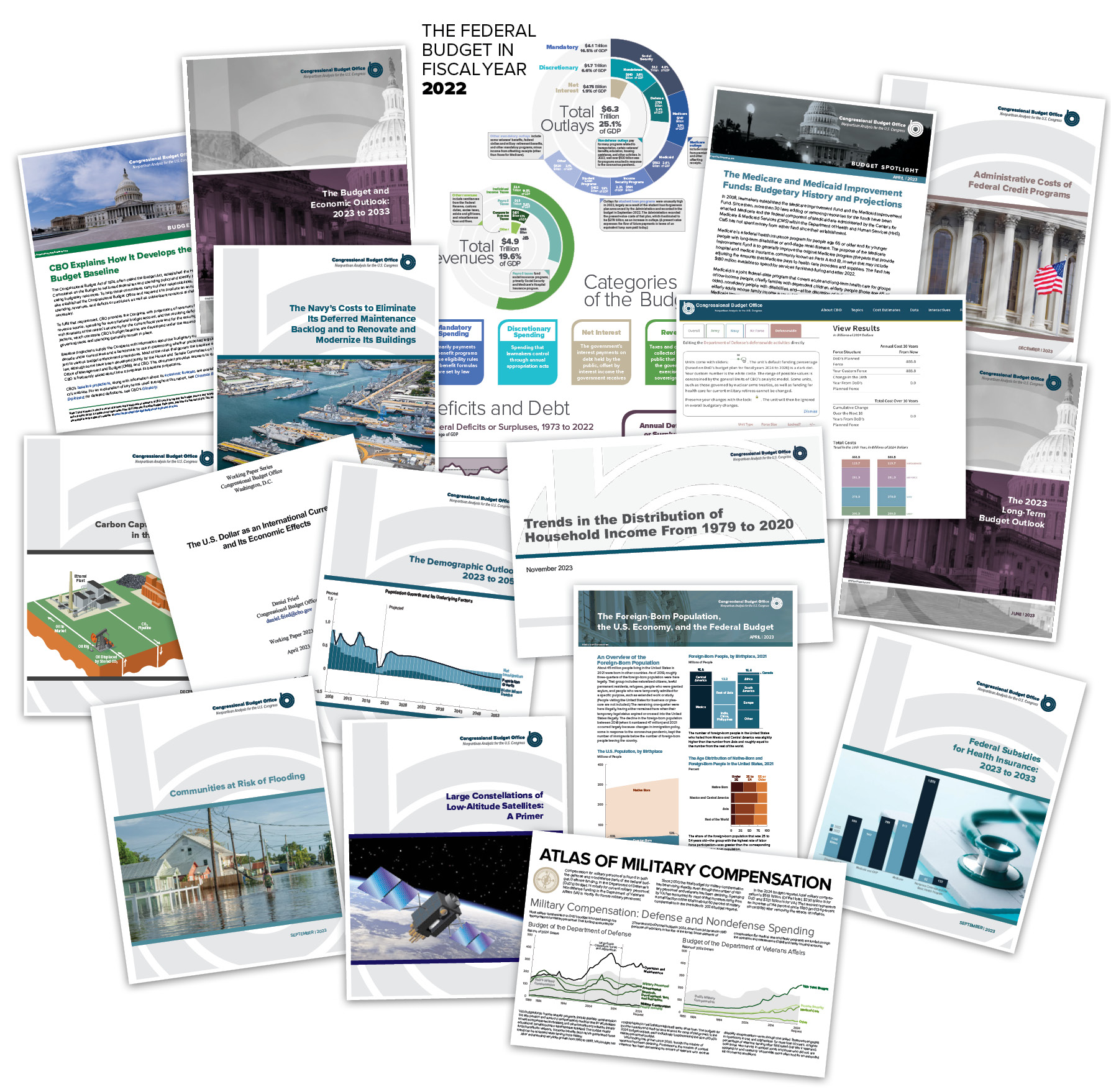
CBO’s First Goal for 2024 and 2025: Providing Budgetary and Economic Information That Is Objective and Insightful
In 2024 and 2025, CBO will ensure, as it has throughout its history, that its work is objective and insightful. With a strong commitment to that mission, the agency will continue its practice of making no policy recommendations and will continue to strive to present the likely consequences of alternative policy proposals.
Many of the products that CBO will produce this year and next are specified by statute—for example, an annual report on the outlook for the budget and the economy and cost estimates for bills reported by committees. CBO’s other analyses address issues being considered by the Congress, provide background information on budgetary and economic conditions that are relevant for the consideration of legislation, or explain the tools that the agency uses to develop projections and estimates. Many of the specific projects that CBO undertakes this year and next will depend on the agency’s budget, on the legislative agenda, and on requests from Congressional committees and leadership. CBO regularly consults with Members and staff about what topics and types of analyses would be most valuable to the Congress, and the agency responds as rapidly as possible to Congressional interest.
The analyses requested by the Congress at times involve new and complex issues; even for recurring issues, a constantly changing context creates new challenges. CBO expends substantial resources to understand the substance underlying policy issues and estimate the budgetary and economic effects of legislative proposals. Many of CBO’s analyses involve assembling evidence from numerous sources, determining and synthesizing the implications of that evidence, and building models to quantify effects of specific proposals and variations of them.
To be ready to provide timely responses to requests, the agency makes ongoing investments in that process. For example, CBO is currently improving its capability for analyzing the effects that proposed legislation related to energy policy and climate change could have on the economy and the federal budget. CBO is also improving its capability for analyzing effects of proposed policies affecting the use of obesity treatments.
Fulfilling Requests for Technical Assistance
At various stages of the legislative process, CBO will provide Congressional committees with technical assistance related to the budgetary effects of proposed legislation; requests for such assistance usually number in the thousands each year. To the extent practicable, CBO will also provide such information to Members’ offices.
Providing Cost Estimates for Authorizing Bills
CBO will provide cost estimates to fulfill the statutory requirement to estimate the cost of bills reported by committees. Upon request, CBO will also provide cost estimates at other stages of the legislative process. Most cost estimates will include estimates of the effects of intergovernmental and private-sector mandates. In addition, for bills considered under suspension of the rules in the House of Representatives, CBO will provide estimates of the effects on mandatory spending and revenues.
Producing Estimates for Appropriation Bills
CBO will estimate the budgetary effects of appropriation bills and provide regular status reports on discretionary appropriations and on the effects of appropriation legislation on mandatory spending and revenues.
Publishing Reports, Working Papers, Testimonies, Slide Decks, Interactive Tools, and Infographics
CBO will produce comprehensive reports about the outlook for the budget and the economy, describing the agency’s baseline budget and economic projections and the basis for them. Working papers will provide additional details on the budgetary and economic trends underlying the projections. In addition, CBO will estimate the budgetary effects of the proposals in the President’s budget.
CBO will also report on the long-term budget outlook, examining how Social Security, Medicare, Medicaid, and other parts of the federal budget are likely to be affected over the coming decades by the aging of the population and growing health care costs per person. And CBO will examine specific issues, such as the long-term costs of the Defense Department’s plans and the costs of the Navy’s shipbuilding plans.
Furthermore, the agency will provide in-depth analyses of various issues, responding to the interests and concerns of Congressional committees and leadership. Those analyses will address broad budgetary issues and an array of other topics, including health care, income security, education, macroeconomic conditions and problems, trade, financial markets, credit programs, taxes, national security, energy, climate change, and infrastructure.
CBO’s Second Goal for 2024 and 2025: Strengthening Responsiveness
CBO seeks to provide information when it is most useful to the Congress. Depending on its purpose, that information takes a variety of forms, such as cost estimates, background information, and technical assistance. In almost all cases, CBO completes a cost estimate before legislation comes to a floor vote. In addition, the agency works to provide technical assistance, reports, and other information to lawmakers and their staff during earlier stages of the legislative process.
Beginning in fiscal year 2019, CBO initiated a multiyear effort to strengthen its responsiveness to the Congress. To carry out that plan, CBO received additional resources to expand staffing in high-demand areas, such as health care and immigration. It has increased its use of assistant analysts, who can move from one topic to another to support more senior analysts when demand surges for analysis of a particular topic or when additional assistance is needed for a complicated estimate. In addition, CBO continues to engage expert consultants in complex areas, such as health policy, agricultural and nutrition programs, economic forecasting, and climate-related research. Finally, the agency is continuing to expand its use of team approaches for large and complicated projects. That approach has been particularly effective in enabling CBO to produce timely analyses of legislation involving health care.
CBO’s goal is to increase the number of staff with overlapping skills within and across teams. In some cases, those skills will consist of expertise related to particular topics, such as defense or transportation. In other cases, they will be more technical, such as the ability to design and improve simulation models. In a similar vein, CBO plans to invest additional resources in bolstering analysts’ ability to coordinate work that requires expertise from across the agency. Another objective is to give additional senior analysts responsibility for projects that span multiple subject areas.
The budgetary increase that CBO is requesting would allow it to increase its efforts to be responsive. In 2025, CBO plans to hire additional staff to produce more timely cost estimates and fulfill more Congressional requests for technical assistance, particularly in the areas (like health care) that involve complicated modeling, and staff to conduct more work in the areas of dynamic analysis, long-term estimates, analysis of defense weapons systems, and estimates of credit programs (like student loan programs)—areas in which CBO expects the Congress to have increased interest.
CBO’s Third Goal for 2024 and 2025: Enhancing Transparency
CBO works hard to make its analysis transparent and plans to strengthen those efforts, building on the increased emphasis that it has placed on the endeavor over the past several years. In 2024 and 2025, many of CBO’s employees will spend part of their time on making the agency’s analyses more transparent.
Testifying and Publishing Answers to Questions
In 2024 and 2025, CBO expects to testify about its baseline projections and other topics in response to requests by the Congress. That work will involve presenting oral remarks, answering questions at hearings, and presenting written statements, as well as publishing answers to Members’ questions for the record. CBO will continue to address issues raised as part of the oversight provided by the House and Senate Budget Committees and the Congress generally.
Explaining Analytical Methods
CBO plans to publish material providing general information to help Members of Congress, their staff, and others better understand its work. For example, a report will explain the agency’s approach to modeling the effects of various policies in the electric power sector. Working papers, too, will provide such explanations for various topics, and in some cases, CBO will be able to publish the computer code used in models.
Releasing Data
In 2024 and 2025, CBO will maintain its practice of publishing extensive sets of data to accompany its major recurring reports, including detailed information about 10-year budget projections, historical budget outcomes, 10-year projections for federal trust funds, revenue projections by category, spending projections by budget account, tax parameters, effective marginal tax rates on labor and capital, and 10-year projections of economic variables, including the economy’s potential (or sustainable) output.
The agency will also provide details about its baseline projections, for example, for the Federal Pell Grant Program, student loan programs, Medicare, military retirement, the Pension Benefit Guarantee Corporation, Social Security Disability Insurance, Social Security Old-Age and Survivors Insurance, the Social Security trust funds, child nutrition programs, the Child Support Enforcement and Child Support Collections programs, foster care and adoption assistance, the Supplemental Nutrition Assistance Program, Supplemental Security Income, Temporary Assistance for Needy Families, unemployment compensation, the Department of Agriculture’s mandatory farm programs, federal programs that guarantee mortgages, programs funded by the Highway Trust Fund, benefits under the Post-9/11 GI Bill, and veterans’ disability compensation and pensions.
Other data will provide details about long-term budget projections, projections underlying Social Security estimates, more than a thousand expired or expiring authorizations of appropriations, and dozens of federal credit programs. When CBO analyzes the President’s budget request, it will post a set of files providing estimates of the budgetary effects of specific proposals. The agency will also continue to post the data underlying various reports’ charts and tables.
Analyzing the Accuracy of CBO’s Estimates
In 2024 and 2025, CBO will continue to release reports analyzing the accuracy of its past projections of outlays, revenues, deficits, and debt. And the agency will compare its projections of federal subsidies for health insurance with actual amounts.
Comparing Current Estimates With Previous Ones
In several of its recurring publications—reports about the budget and economic outlook, federal subsidies for health insurance, and the long-term budget outlook—CBO will continue to explain the differences between the current year’s projections and those produced in the previous year. In its cost estimates, CBO will continue to identify related legislative provisions for which it has provided recent estimates and explain the extent to which the provisions and estimates at hand are similar or different.
Comparing CBO’s Estimates With Those of Other Organizations
CBO will compare its budget projections with the Administration’s and its economic projections with those of private forecasters and other government agencies when possible. In addition, in various reports, the agency will include comparisons of its estimates with estimates made by other organizations. When time does not allow for publication but interest is great, analysts will discuss such comparisons with Congressional staff.
Estimating the Effects of Policy Alternatives
In 2024 and 2025, CBO will update some of its interactive tools and release new ones to help the Congress and the public better understand the effects of potential changes to federal policies. Reports will also illustrate the potential effects of various policy proposals.
Characterizing the Uncertainty of Estimates
CBO will update an interactive workbook showing its estimates of how changes in economic conditions affect the federal budget. The agency’s reports about the 10-year outlook for the budget and the economy, the long-term outlook for the budget, and federal subsidies for health insurance will contain substantial discussions of the uncertainty of CBO’s projections. In addition, in most cost estimates in which uncertainty is significant, CBO will include a discussion of the topic.
Creating Data Visualizations
In 2024 and 2025, CBO will provide information about its budget and economic projections in slide decks and create infographics about actual outlays and revenues. The agency will also produce more reports that rely principally on visual presentations. And it will look for opportunities to include graphics to enhance the explanations in some cost estimates.
Conducting Outreach
CBO will continue to communicate regularly with Congressional staff and others outside the agency to explain its findings and methods, respond to questions, and obtain feedback. The agency’s Director will meet frequently with Members of Congress to do the same. After each set of baseline projections is published, CBO’s staff will meet with Congressional staff to discuss the projections and answer questions.
CBO will obtain input from its Panel of Economic Advisers, its Panel of Health Advisers, and other experts. Many reports will benefit from outside experts’ written comments on preliminary versions. For some recurring reports produced on compressed timetables, such as the one about CBO’s long-term budget projections, the agency will solicit comments on previous publications and selected technical issues to incorporate improvements in future editions.
CBO’s staff will give presentations on Capitol Hill—some in collaboration with Congressional committees and the Congressional Research Service—on CBO’s budget and economic projections and on other topics. Those presentations will allow CBO to explain its work and answer questions. The agency will also give presentations about its findings and about work in progress in a variety of venues to offer explanations and gather feedback. In addition, CBO will use blog posts to summarize and highlight various issues.
Finally, to keep the Congress informed of its work, CBO will continue its practice of sending an email to interested staff notifying them about recently released reports and cost estimates. The agency will also continue publishing a recently initiated quarterly newsletter, CBO’s Quarter in Review, which is a roundup of the agency’s most recent publications and cost estimates. The newsletter is a companion to quarterly reports listing recent publications and work in progress, which may include reports, working papers, testimonies, interactive tools, infographics, and cost estimates.
CBO’s Fourth Goal for 2024 and 2025: Improving Internal Operations
In addition to directly serving the Congress, CBO develops employees’ skills and provides the technological infrastructure to help them be as productive as possible.
Developing Employees’ Skills
CBO continues to place a priority on staff development in 2024 and beyond, but it has had to limit external training for its current employes because of the constraining fiscal year 2023 appropriation that continued for half of 2024. The agency plans to resume that training to fully integrate new employees. As expected, an increased number of retirements occurred over the past two years, so the agency has focused on knowledge transfer and knowledge management. CBO has also prioritized internal leadership development, as a number of internal promotions to management positions have occurred in the past year.
Following the belt-tightening that eliminated much training and travel, CBO plans to resume funding participation in conferences of researchers, practitioners, and government employees on various economic and policy topics, as well as training in analytical tools and various skills. To aid in succession planning and continuity of operations, CBO will put a premium on knowledge transfer, knowledge management, and the development of leadership skills.
To remain fiscally prudent, the agency will continue to take advantage of opportunities for more flexible training that is delivered virtually. It will also continue to develop employees’ skills through internal training and training by sister agencies when it can.
Maintaining and Improving Technological Infrastructure
CBO continually works to maintain and improve its technological infrastructure and, especially recently, technologies that support a hybrid work environment. In 2024 and 2025, the agency plans to continue these endeavors:
- Updating and transforming desktop computers and file storage to increase capabilities, enhance ease of use, and improve disaster recovery capability;
- Improving its ability to detect, assess, and recover from cyberattacks by adding relevant software and systems and by testing the systems’ capabilities to withstand attacks;
- Improving network connections to ensure that they remain resilient and available to support remote work capabilities;
- Investing in cloud computing technologies to provide high-performing computing that is flexible and efficient;
- Implementing enhanced security systems to minimize CBO’s “attack surface”; and
- Implementing what is termed endpoint threat detection and response, which involves continuously monitoring the agency’s computers to guard against advanced, persistent threats and ransomware.
Appendix A: Detailed Tables
This appendix provides a detailed breakdown of the Congressional Budget Office’s past budgets and requested appropriations for fiscal year 2025, as well as some additional information.
See Table A-1 for a summary of salaries and expenses;
See Table A-2 for those items broken down by object class;
See Table A-3 for the change in those items between the fiscal year 2024 funding and the current request;
See Table A-4 for a staffing summary;
See Table A-5 for supplemental data on mandatory pay increases in CBO’s request;
See Table A-6 for price-level increases in the request;
See Table A-7 for 10-year data on salaries and expenses;
See Table A-8 for spending for advertising services; and
See Table A-9 for projected recruitment expenses.
Table A-1.
Summary of Salaries and Expenses Appropriation, by Organizational Unit
Thousands of dollars

Numbers sometimes do not add up to totals because of rounding.
FTE = full-time-equivalent position; FY = fiscal year.
a. Cumulative number of FTEs over the course of the year.
b. Includes the Office of Communications and the Office of the General Counsel.
Table A-4.
Staffing Summary

Numbers sometimes do not add up to totals because of rounding.
FTE = full-time-equivalent position; FY = fiscal year.
a. Number of employees at the end of the year.
b. Cumulative number of FTEs over the course of the year.
c. Based on the number of employees projected for the end of the previous year, minus projected terminations and plus projected hires for the specified year, and allowing for lag time between terminations and hires.
d. Includes the Office of Communications and the Office of the General Counsel.
Appendix B: Detailed Object Class Analysis
The details of the Congressional Budget Office’s requested appropriation for fiscal year 2025 are explained below.
Basis for CBO’s Budget Estimates—Personnel Costs
CBO derived these projections of personnel costs with its internally developed software for tracking current payroll costs and projecting future payroll costs. The projections are based on employee-level payroll data at the object class level. In the past, payroll budget projections derived with that software have proved to be highly accurate.
Object Class 11—Full-Time and Part-Time Employees: $47,131,600
- $45,526,600 for Base Pay—funds an average of 278 full-time-equivalent positions (FTEs) for the fiscal year, which would allow the agency to increase the number of staff members to 285 by the end of the fiscal year. That amount constitutes an overall net increase of $2,256,000 from the amount CBO expects to spend in fiscal year 2024. Of the increase:
- $600,000 is for an across-the-board pay increase (if such an increase is authorized for executive branch agencies for 2025) of 4.5 percent in January 2025 for staff whose salary is less than $100,000 and 2.5 percent for staff making $100,000 or more.
- $501,000 is for performance-based pay increases in 2025. CBO uses a performance-based system to reward its employees. Pay increases are based on employees’ accomplishments in the previous year, as reflected in annual performance reviews. Employees’ performance is assessed according to five criteria: quality of work, timeliness and productivity, initiative, written and oral communication skills, and effectiveness of working relationships. Managers’ performance is also assessed according to a sixth criterion, leadership. CBO’s Director makes the final decisions on all pay changes. Maintaining the ability to reward performance is essential in view of the competitive job markets for economists, budget analysts, and other professionals.
- $437,500 supports an increase of four FTEs in 2025. That number of FTEs represents nine staff members to be hired during 2025.
- $429,500 is for the costs in 2025 of prior-year personnel actions (performance-based increases and promotions).
- $165,000 is for restoring the agency’s summer intern program (which was cut in fiscal year 2024), accounting for three FTEs. CBO’s interns work on important projects and often return to the agency as analysts after they complete their graduate studies.
- $123,000 is for performance-based pay increases in 2025 for employees other than full-time permanent employees.
- $975,000 for Performance Bonuses for Top Performers—funds bonuses that enable CBO to control long-term compensation costs while helping the agency retain its outstanding performers in competitive job markets. The amount is the same as that provided in fiscal year 2024.
- $600,000 for Leave Buyout Costs—funds mandatory leave buyout costs for employees who depart. The amount, which is based on current data and projected departures, is the same as that provided in fiscal year 2024. If leave buyout costs turned out to be higher than that amount, CBO would delay filling vacated positions to cover the costs.
- $30,000 for Overtime Pay—funds overtime pay for nonexempt employees. The amount is the same as that in fiscal year 2024. Currently, CBO has 11 employees serving in nonexempt positions, in which they provide technical support. CBO must pay employees in nonexempt positions overtime if they work more than 40 hours per week, which happens in the rare cases when timely support of the Congress would be impaired if the work was not performed.
Object Class 12—Personnel Benefits: $18,405,300
- $9,578,800 for the Federal Employees Retirement System (FERS) and Civil Service Retirement System (CSRS)—funds mandatory retirement benefits in FERS and CSRS. That amount, which constitutes an increase of $672,000 from the amount CBO expects to spend in fiscal year 2024, is based on several factors: the projected base pay of current employees and ones the agency anticipates hiring, along with anticipated attrition. Benefit rates for 2025 are 25.7 percent for FERS employees who joined the government before December 31, 2012; 16.5 percent for FERS employees who arrived after that date; and 7.5 percent for CSRS and CSRS Offset employees. (Benefit rates are the percentage of employees’ salaries that CBO is required to pay to the two retirement systems.)
- $2,795,800 for Social Security Payroll Taxes—funds mandatory benefit costs for CBO employees subject to the Social Security payroll tax. That amount, which constitutes an increase of $338,800 from the amount CBO expects to spend in fiscal year 2024, is projected on the basis of an estimated maximum taxable amount of $177,440 for each employee, along with a reduction for anticipated attrition.
- $2,687,000 for Health Insurance—funds mandatory health benefit costs. That amount constitutes an increase of $256,100 from the amount CBO expects to spend in fiscal year 2024. The increase results from increases in premiums for health insurance and in the anticipated size of CBO’s staff.
- $1,709,400 for FERS Thrift Savings Plan (TSP) Government Matching Contributions—funds mandatory government matching contributions. That amount, which constitutes an increase of $108,700 from the amount CBO expects to spend in fiscal year 2024, is projected on the basis of matching benefits for current employees, their current annualized salaries, and a reduction for anticipated attrition. The historical matching benefit for CBO has been roughly 3.7 percent of base pay.
- $692,000 for Medicare Payroll Taxes—funds mandatory benefit costs for CBO employees. That amount, which constitutes an increase of $70,000 from the amount CBO expects to spend in fiscal year 2024, equals 1.45 percent of base pay, with a reduction for anticipated attrition.
- $450,700 for the FERS TSP Government Basic Contribution—funds the mandatory FERS TSP matching benefit of 1 percent. That amount, which constitutes an increase of $36,600 from the amount CBO expects to spend in fiscal year 2024, is projected on the basis of the benefits paid to current employees, their current annualized salaries, and a reduction for anticipated attrition.
- $168,000 for Recruitment Bonuses—funds a valuable recruiting tool for the agency. The same amount was provided in fiscal year 2024.
- $150,000 for the Transit Benefit Program—funds mandatory employee benefits that are associated with CBO’s Transit Benefit Program. The same amount was provided in fiscal year 2024.
- $100,000 for Death Benefit—funds a payment to a person’s family if the person dies while employed by the agency. The same amount was allocated in fiscal year 2024.
- $64,400 for Life Insurance—funds mandatory life insurance benefits for employees. That amount, which constitutes an increase of $5,400 from the amount CBO expects to spend in fiscal year 2024, is projected on the basis of historical data and equals 0.14 percent of base pay.
- $6,000 for the Federal Flexible Spending Account Program (FSAFEDS)—funds mandatory costs for FSAFEDS. That amount, which is the same amount as that provided in fiscal year 2024, is projected on the basis of employees’ historical use of the program.
- $3,200 for Workers’ Compensation—funds mandatory payments for workers’ compensation should claims arise. The amount is the same as that provided in fiscal year 2024.
Basis for CBO’s Budget Estimates—Nonpersonnel Costs
CBO projected nonpersonnel costs on the basis of its past experience and plans for the upcoming year.
Object Class 21—Travel: $200,000
- $200,000 for Travel—funds travel for the outside experts who participate in two meetings of the agency’s Panel of Economic Advisers and one meeting of the agency’s Panel of Health Advisers to support the development and review of the agency’s analyses; funds employees’ attendance at the annual Allied Social Science Association conference, which is an important venue for recruiting; and funds travel for employees to attend various conferences and training courses, including management and leadership training. The amount is based on anticipated requirements. It is an increase of $16,400 from the amount CBO expects to spend in fiscal year 2024.
Object Class 23.3—Communications, Utilities, and Miscellaneous Charges: $399,300
- $395,000 for Telecommunications and Telephone Services—funds local and long-distance telephone services, smartphone service for some CBO personnel, and secure telecommunication links to support Internet and intranet services. Those links and services between CBO’s offices at the Ford House Office Building and its secondary data center enable the agency’s information technology (IT) staff to conduct daily administrative tasks and to replicate data and systems at both locations so that if a disaster occurred at the Ford Building, the agency could continue operating at the other location. The amount is a decrease of $113,000 from the amount CBO expects to spend in fiscal year 2024, during which the agency will be able to make some onetime purchases.
- $4,300 for Mail Service—funds postage, couriers, and mail services. The amount is based on anticipated requirements and is an increase of $1,700.
Object Class 24—Printing and Reproduction: $8,000
- $8,000 for Publications—funds the printing of publications through the Government Publishing Office, as well as other miscellaneous printing requirements involving CBO’s products for the Congress. The amount is based on anticipated requirements and is an increase of $3,000 from the amount CBO expects to spend in fiscal year 2024.
Object Class 25—Other Services: $6,394,400
- $3,006,100 for IT Commercial Data and Time Sharing—funds purchases of data about health care, domestic and international banking and financial markets, and other topics in support of the agency’s analyses, as well as software and cloud services for additional capabilities and disaster recovery. The amount, based on anticipated requirements, would pay for deferred expenses and return to the historical trend for such spending. It is an increase of $727,900 from what CBO expects to spend in fiscal year 2024.
- $837,900 for Expert Consultants—funds access to outside experts—particularly those in the areas of health care, agricultural programs and nutrition, economic forecasting, and climate-related research—to assist in the preparation of cost estimates and analyses; outside reviews of drafts of analyses; and legal support. The amount, an increase of $48,800 over the amount in fiscal year 2024, would help CBO have the flexibility to shift to address the Congress’s key areas of focus.
- $640,700 for Equipment Maintenance and Repair—funds a broad array of IT items needed for operations. Whenever possible, CBO takes a cost-effective approach to maintenance and repair by negotiating agreements to cover one or more years instead of paying for service and support as they become necessary. In addition, CBO leases copiers and printers to reduce costs. The amount is an increase of $1,150 from the amount the agency expects to spend in fiscal year 2024.
- $739,100 for Other Contractors for Professional Services—funds support for various CBO divisions and units for security and administrative services, work in IT, and financial management. The amount is a decrease of $16,400 from the amount the agency expects to spend in fiscal year 2024.
- $359,500 for IT System Development and Support—funds major software installations, upgrades, and support. The amount, based on anticipated requirements, is a decrease of $653,300 from the amount the agency expects to spend in fiscal year 2024, in part to cover deferred purchases that will not recur in fiscal year 2025.
- $250,000 for Training—funds CBO analysts’ participation in conferences; technical training in data analysis (including in statistical analysis software), economic modeling, business and report writing, and IT systems and software; and management training for managers. To constrain expenses in this area, CBO conducts internal training and takes advantage of training provided by sister agencies to the extent possible. The amount is based on anticipated requirements and is a decrease of $34,600 from the amount provided in fiscal year 2024.
- $152,000 for Editing and Publications Contractor Support—principally funds services by contractors to help produce CBO’s publications. The contractors are used to augment the agency’s editing capacity, particularly during peak workload periods. The amount, based on anticipated requirements, is a decrease of $65,000 from the amount the agency expects to spend in fiscal year 2024, during which the agency will be able to establish some contracts that extend into next year.
- $133,100 for the Financial Management System (Momentum)—funds annual costs of CBO’s maintenance support for Momentum. The amount is based on anticipated requirements. It is a decrease of $14,800 from the amount the agency expects to spend in fiscal year 2024.
- $130,800 for Financial Management Support—funds an interagency agreement with the Library of Congress, the agency’s independent annual financial statement audit, and contractor services to support internal financial operations. The amount is an increase of $31,400 from what CBO expects to spend in fiscal year 2024.
- $98,500 for Human Resources Contract Support—funds a variety of costs related to CBO’s personnel, including costs for posting job announcements to the USAJobs website, advertising open positions, and retaining personnel records, as well as minor costs associated with employment services, such as retirement counseling. The amount also funds the initial implementation costs of a system that will improve the agency’s continuity of operations plans and enhance telework by its human resources staff. The amount is an increase of $13,900 from the amount CBO expects to spend in fiscal year 2024.
- $40,700 for Payroll Processing Support—funds comprehensive payroll (and related benefits) processing for CBO by the National Finance Center. The center provides human resources and payroll services to more than 140 government agencies (including all agencies in the legislative branch), offering more efficient and cost-effective services than those agencies would otherwise be able to obtain. The amount is based on anticipated requirements and is an increase of $700 from the amount CBO expects to spend in fiscal year 2024.
- $6,000 for Official Representation—funds events such as meetings of the Panel of Economic Advisers and the Panel of Health Advisers, meetings involving other outside analysts, and minority recruitment events. The amount is based on anticipated requirements and is the same as the amount provided in fiscal year 2024.
Object Class 26—Supplies and Materials: $400,800
- $318,500 for Library Subscriptions—funds library (primarily online) subscriptions to a variety of publications and services, including Congressional Quarterly, Lexis-Nexis, EconLit, EBSCO, the Wall Street Journal, Inside Washington Publishers, and Energy & Environment. The amount is based on anticipated requirements and is an increase of $27,800 from the amount CBO expects to spend in fiscal year 2024.
- $82,300 for Office Supplies—funds expenses for office supplies, reasonable accommodations for employees’ requirements under the Americans With Disabilities Act, paper, envelopes, emergency response kits required for evacuation drills, award supplies, and other items. Funding in this category was significantly cut in fiscal year 2024 under the continuing resolution that was in effect for half the year. The increase, $40,500, would return funding in this category to the historical level.
Object Class 31—Equipment: $569,200
- $483,000 for Hardware—funds the purchase and replacement of CBO’s laptops and desktops so that the agency can replace hardware that is aging or at the end of its life cycle and can continue to move workstations to the cloud. The amount is based on anticipated requirements and is a decrease of $310,500 from the amount CBO expects to spend in fiscal year 2024. Much of the agency’s spending for IT in 2024—including purchases of equipment, cybersecurity, and cloud services—is for deferred projects that will not recur in 2025.
- $78,600 for Office Furniture—funds office furniture for new personnel and the replacement of worn-out furniture. The amount, an increase of $58,200 from the amount CBO expects to spend in fiscal year 2024, is based on anticipated requirements and would return funding for this purpose to its historical level.
- $6,600 for Software—funds the purchase of various software and data security requirements to strengthen the agency’s internal and cloud networks to stay ahead of expanding IT security threats. The amount is an increase of $600 from the amount CBO expects to spend in fiscal year 2024.
- $1,000 for Books—funds the purchase of books used by CBO’s staff to meet analytical requirements. The amount is based on anticipated requirements and is the same as the amount the agency expects to spend in fiscal year 2024.
Appendix C: Key Staffing Changes and Organization Charts
This appendix describes key staffing changes at the Congressional Budget Office over the past year. It then presents the agency’s organization charts.
Key Staffing Changes in 2023
CBO had four key staffing changes among managers in 2023.
Chad Chirico was promoted in June 2023 to become the Director of CBO’s Budget Analysis Division. As Director of Budget Analysis, he guides and contributes to analyses that are critical to the legislative processes of the Congress—including projections of federal spending for the current year and the next 10 years under current laws and policies for about 1,000 budget accounts covering all federal activities, tallies of federal spending throughout the year, about 600 to 800 cost estimates (most of which include estimates of the cost of federal mandates on state, local, and tribal governments) each year for legislation approved by committees, and thousands of requests for technical assistance for legislation under consideration.
He came to CBO in 2001 to join what was then the Human Resources Cost Estimates Unit. As an analyst, he was responsible for cost estimates and baseline projections for federal housing programs and worked on a wide range of federal credit policies. In 2014, he became the head of the Low-Income Health Programs and Prescription Drugs Cost Estimates Unit. In that capacity, he oversaw the division’s analysis related to Medicaid, employment-based health insurance, the health insurance marketplaces, the Food and Drug Administration, and public health programs. Before coming to CBO, he was a consultant for Ernst and Young and Quadel Consulting, working principally on housing and real estate finance issues and on budget preparation. He graduated from Dickinson College with a bachelor’s degree in political science and received a master’s degree in public administration, with a focus on public finance, from George Washington University.
Christina Hawley Anthony was promoted in June 2023 to become one of two deputies in CBO’s Budget Analysis Division. As Deputy Director of Budget Analysis, she works with the division’s Director to manage a wide array of topics, including health, defense, international affairs, and veterans’ issues.
She began her career at CBO in 1995 as the unemployment compensation and labor analyst in the division’s Income Security Unit. In 2004, she began splitting her time between that unit and the Projections Unit, as she took on the responsibility of writing major portions of CBO’s Budget and Economic Outlook and Analysis of the President’s Budget. From 2017 to 2023, she was the Chief of the Projections Unit. In that capacity, she managed the development, dissemination, and communication of CBO’s baseline projections. While in that role, she oversaw the creation of a number of interactive tools and infographics to aid in the analysis and communication of budget topics. Before coming to CBO, she served in the State of Maryland’s Federal Relations Office and as a Maryland Governor’s Policy Fellow. She holds a Master of Public Affairs degree from the University of Texas at Austin and a Bachelor of Arts degree in foreign service from Baylor University, in Waco, Texas.
Chapin White was promoted in June 2023 to become the Director of CBO’s Health Analysis Division. In that role, he leads the agency’s analysis of health policy issues and oversees CBO’s health insurance simulation model. The division produces reports on a range of policy issues and plays a key role in certain estimates of proposed changes in health care programs.
Dr. White is a health economist who joined CBO in 2004 and then worked at the RAND Corporation and the Center for Studying Health System Change before rejoining CBO in 2020. His areas of expertise include price transparency, health insurance coverage, provider payment policy, surprise billing, and microsimulation modeling. He holds an A.B. from Harvard College, an M.P.P. from the Harvard Kennedy School, and a Ph.D. in health policy from Harvard University.
Tamara Hayford was promoted in June 2023 to become the Deputy Director of CBO’s Health Analysis Division. In that role, she works with the division’s Director to manage a range of federal programs and policies that include Medicare, Medicaid, and subsidies provided through health insurance exchanges.
Dr. Hayford was previously the Chief of the Health Policy Studies Unit. In that position, she oversaw reports and policy analysis on topics such as prescription drugs, the opioid crisis, mental health, and other public health issues. In addition, she guided a team of researchers analyzing the impacts that proposed legislation and regulatory changes affecting prescription drug pricing could have on the federal budget and the long-term pipeline for pharmaceutical innovation. She joined CBO in 2009 as an analyst and worked on various health care topics, including prescription drugs, spending patterns and access to care for people who are dually enrolled in Medicare and Medicaid, providers’ responses to changes in payment rates and demand for services, Medicare Advantage and risk adjustment, hospitals’ profitability, and quality measurement initiatives in the Medicare program. She received her doctorate in economics from the University of Maryland, College Park. She received her bachelor’s degree in international relations and physics from the College of William and Mary, in Williamsburg, Virginia.
This section shows CBO’s organizational structure and lists the names of all of CBO’s managers.
See Figure C-1, for the organization chart of the entire agency;
See Figure C-2, for the Budget Analysis Division;
See Figure C-3, for the Financial Analysis Division;
See Figure C-4, for the Health Analysis Division;
See Figure C-5, for the Labor, Income Security, and Long-Term Analysis Division;
See Figure C-6, for the Macroeconomic Analysis Division;
See Figure C-7, for the Management, Business, and Information Services Division;
See Figure C-8, for the Microeconomic Studies Division;
See Figure C-9, for the National Security Division; and
See Figure C-10, for the Tax Analysis Division.
Appendix D: CBO’s Products and Internal Operations in 2023
During calendar year 2023, the Congressional Budget Office continued to provide the Congress with high-quality budgetary and economic analysis and strived to be as responsive as possible to Congressional needs. That effort took a number of forms, including technical assistance, cost estimates for authorizing and appropriation bills, and analytic reports and other products. The agency also made improvements in its internal operations.
Technical Assistance
In 2023, CBO fulfilled thousands of requests for technical assistance as committees were crafting legislation, as amendments to bills were being debated, and at other stages in the legislative process. The agency’s analysts often provide preliminary estimates to committee staff and the leadership of the House or the Senate, helping them weigh different options for achieving legislative goals. To the extent practicable, CBO also provides information to Members’ offices. The assistance typically happens through a combination of email, phone calls, face-to-face meetings, and virtual meetings.
A key focus of its technical assistance in 2023 was on annual appropriation bills and the reauthorization of the farm bill as committees developed their legislation. In addition, CBO provided information about the budgetary effect of thousands of amendments to appropriation bills and versions of the National Defense Authorization Act for Fiscal Year 2024 (Public Law 118-31).
Cost Estimates for Authorizing Bills
In 2023, CBO completed 675 cost estimates—mostly to fulfill the statutory requirement to provide estimates of the cost of bills ordered reported by committees. CBO devoted significant resources to analyzing the Fiscal Responsibility Act of 2023 (P.L. 118-5), the National Defense Authorization Act, and H.R. 1, the Lower Energy Costs Act. The cost estimates generally included explanations of their components and of the estimating methods used. Most also included mandate statements, which assess whether legislation contains intergovernmental or private-sector mandates as defined in the Unfunded Mandates Reform Act and, if so, assess the magnitude of the mandates’ effects on the private sector and on state, local, and tribal governments.
CBO published estimates for 97 percent of the bills ordered reported by an authorizing committee before they were considered on the floor of either the House or the Senate. CBO also reviewed 183 bills in 2023 that were scheduled to be considered under suspension of the rules in the House.
Cost Estimates for Appropriation Bills
In 2023, CBO provided about 100 cost estimates for appropriation bills, including reports with account-level detail for individual bills at all stages of the legislative process, summary tables showing the status of discretionary appropriations (by appropriations subcommittee), and running totals of the budgetary effects of enacted legislation on a year-to-date basis. The number of such estimates required for an appropriation cycle can vary depending on its duration and complexity; in recent years, that number has ranged from about 100 to 150.
Analytic Reports and Other Publications
CBO provides analytic reports and other publications to policymakers throughout the legislative process. In 2023, CBO described its baseline projections in a major report about the budget and economic outlook in February. The agency updated its budget projections in May, its annual long-term budget projections in June, and its economic projections in July and December. In a number of reports, responding to interest expressed by Members of Congress, CBO provided distributional analyses of policy proposals on the basis of the age, education, income or wealth, race or ethnicity, or sex of the people who might be affected. For a catalog of that work, see “Distributional Analysis” on CBO’s website, www.cbo.gov/about/distributional-analysis.
All told, the agency produced 102 reports, working papers, testimonies, slide decks, interactive tools, and infographics last year; they are arrayed by topic below. Other publications included presentations, letters to Members of Congress, and blog posts.
Projections and Budgetary Issues in Major Recurring Reports
The Accuracy of CBO’s Budget Projections for Fiscal Year 2023 (December)
The 2023 Long-Term Budget Outlook (June)
CBO’s 2023 Long-Term Projections for Social Security (June)
An Analysis of the Discretionary Spending Proposals in the President’s 2024 Budget (May)
An Update to the Budget Outlook: 2023 to 2033 (May)
Expired and Expiring Authorizations of Appropriations for Fiscal Year 2023 (April)
The Budget and Economic Outlook: 2023 to 2033 (February)
The Demographic Outlook: 2023 to 2053 (January)
The Accuracy of CBO’s Budget Projections for Fiscal Year 2022 (January)
Monthly Budget Review (12 issues)
General Budgetary Issues
Administrative Costs of Federal Credit Programs (December)
CBO’s Projections of Federal Receipts and Expenditures in the National Income and Product Accounts: 2023 to 2033 (September)
Sequestration Update Report: August 2023 (August)
The Long-Term Budget Outlook Under Alternative Scenarios for the Economy and the Budget (July)
How the Fiscal Responsibility Act of 2023 Affects CBO’s Projections of Federal Debt (June)
Budgetary Outcomes Under Alternative Assumptions About Spending and Revenues (May)
Federal Debt and the Statutory Limit, May 2023 (May)
CBO Explains Its Principles for Identifying Mandates in Legislation (May)
CBO Explains the Statutory Foundations of Its Budget Baseline (May)
CBO Explains How It Estimates Savings From Rescissions (May)
How Changes in Economic Conditions Might Affect the Federal Budget: 2023 to 2033 (April)
An Evaluation of CBO’s Projections of Outlays From 1984 to 2021 (April)
CBO Describes Its Cost-Estimating Process (April)
CBO Explains How It Develops the Budget Baseline (April)
Report on the Troubled Asset Relief Program—April 2023 (April)
Legislation Enacted in the Second Session of the 117th Congress That Affects Mandatory Spending or Revenues (March)
The Federal Budget in Fiscal Year 2022: An Infographic (Interactive tool, March)
Workbook for How Changes in Economic Conditions Might Affect the Federal Budget: 2023 to 2033 (Interactive tool, March)
CBO’s Waterfall Model for Projecting Discretionary Spending, March 2023 (Interactive tool, March)
The Federal Budget in Fiscal Year 2022 (set of four infographics, March)
Federal Debt and the Statutory Limit, February 2023 (February)
Climate and Environment, and Disaster Preparation and Relief
Carbon Capture and Storage in the United States (December)
Flood Damage and Federally Backed Mortgages in a Changing Climate (November)
Communities at Risk of Flooding (September)
Defense and National Security
Income of Working-Age Veterans Receiving Disability Compensation (December)
Atlas of Military Compensation (Infographic, December)
The Navy’s Costs to Eliminate Its Deferred Maintenance Backlog and to Renovate and Modernize Its Buildings (November)
CBO’s Interactive Force Structure Tool (Interactive tool, November)
Long-Term Implications of the 2024 Future Years Defense Program (October)
An Analysis of the Navy’s 2024 Shipbuilding Plan (October)
Purposes and Uses of Special and Incentive Pay for Military Personnel (July)
Alternative Ways to Provide Fuel Within the Department of Defense (Slide deck, July)
Approaches to Reducing the Department of Defense’s Compensation Costs (Testimony, July)
DECKPLATE and AMSRR: Comparing Two Ways to Measure the Availability of F/A-18E/F Super Hornet Aircraft (July)
Projected Costs of U.S. Nuclear Forces, 2023 to 2032 (July)
Large Constellations of Low-Altitude Satellites: A Primer (May)
Availability and Use of F-35 Fighter Aircraft: An Update (February)
Availability and Use of the F/A-18E/F Super Hornet Fighter Aircraft (February)
U.S. Hypersonic Weapons and Alternatives (January)
Long-Term Implications of the 2023 Future Years Defense Program (January)
Economy
CBO’s Current View of the Economy From 2023 to 2025 (December)
Conditional Forecasting With a Bayesian Vector Autoregression (Working paper, November)
An Update to the Economic Outlook: 2023 to 2025 (July)
The Economic and Budgetary Effects of Discretionary Funding Caps as Specified in the Limit, Save, Grow Act of 2023 (July)
CBO’s Economic Forecasting Record: 2023 Update (Testimony, June)
Automatic Stabilizers in the Federal Budget: 2023 to 2033 (June)
Effects of Fiscal Policy on Inflation: Implications of Supply Disruptions and Economic Slack (Working paper, April)
The U.S. Dollar as an International Currency and Its Economic Effects (Working paper, April)
The Effects of Work Requirements on the Employment and Income of TANF Participants (Working paper, March)
The Economic Outlook for 2023 to 2033 in 16 Charts (February)
Assessing the Budgetary Implications of Economic Uncertainty With CBO’s Incomes Model and Budgetary Feedback Model (Slide deck, January)
Estimating the Uncertainty of the Economic Forecast Using CBO’s Expanded Markov-Switching Model (Slide deck, January)
Estimating the Uncertainty of the Economic Forecast Using CBO’s Bayesian Vector Autoregression Model (Slide deck, January)
Finance
Estimates of the Cost of Federal Credit Programs in 2024 (August)
Financial Commitments of Federal Credit and Insurance Programs, 2012 to 2021 (March)
Health Care
Exploring the Effects of Medicaid During Childhood on the Economy and the Budget (Working paper, November)
Alternative Payment Models and the Slowdown in Federal Health Care Spending (Testimony, October)
Federal Subsidies for Health Insurance: 2023 to 2033 (September)
Federal Budgetary Effects of the Activities of the Center for Medicare & Medicaid Innovation (September)
The Medicare and Medicaid Improvement Funds: Budgetary History and Projections (April)
Budgetary Effects of Policies to Modify or Eliminate Medicaid’s Institutions for Mental Diseases Exclusion (April)
How CBO Estimated the Budgetary Impact of Key Prescription Drug Provisions in the 2022 Reconciliation Act (Slide deck, February)
“Lesser-of” Payment Policies and the Use of Physicians’ Services Among Dual-Eligible Beneficiaries (Working paper, January)
Income Distribution
The Distribution of Household Income in 2020 (November)
Defined Benefit and Defined Contribution Plans and the Distribution of Family Wealth (Working paper, February)
Trends in the Distribution of Household Income From 1979 to 2020 (Slide deck, November)
Infrastructure and Transportation
The Status of the Highway Trust Fund: 2023 Update (Testimony, October)
Modeling the Demand for Electric Vehicles and the Supply of Charging Stations in the United States (Working paper, September)
Population
CBO’s Demographic Projections (Testimony, November)
The Foreign-Born Population, the U.S. Economy, and the Federal Budget (April)
Social Security
Social Security’s Finances (Testimony, July)
Answers to Questions for the Record Following a Hearing on Social Security’s Finances (May)
Social Security’s Finances (Testimony, April)
Taxes
How CBO Projects Corporate Income Tax Revenues (Slide deck, October)
Trends in Corporate Economic Profits and Tax Payments, 1998 to 2017 (May)
How Changes in Revenues and Outlays Would Affect Debt Service, Deficits, and Debt (Interactive tool, February)
CBO’s Projections of Realized Capital Gains Subject to the Individual Income Tax (Slide deck, February)
Recent Changes to CBO’s Projections of Remittances From the Federal Reserve (Slide deck, February)
Publications on CBO’s Operations
In addition to its analytic reports, CBO published some reports on its own operations, principally to keep the Congress informed about the agency’s work:
CBO’s Recent Publications and Work in Progress as of September 30, 2023 (October)
CBO’s Recent Publications and Work in Progress as of June 30, 2023 (July)
A Guide for Choosing Graphics (May)
CBO’s Recent Publications and Work in Progress as of March 31, 2023 (April)
Transparency at CBO: Future Plans and a Review of 2022 (March)
The Congressional Budget Office’s Request for Appropriations for Fiscal Year 2024 (Senate testimony, March)
The Congressional Budget Office’s Request for Appropriations for Fiscal Year 2024 (House testimony, March)
The Congressional Budget Office’s Request for Appropriations for Fiscal Year 2024 (February)
CBO’s Recent Publications and Work in Progress as of December 31, 2022 (January)
An Introduction to the Congressional Budget Office (January)
Enhancing Transparency
Transparency is an essential part of CBO’s long-standing commitment to providing clear, objective, insightful, and timely information to the Congress and the public. In 2023, CBO focused on bolstering the transparency of its methods and data in a variety of ways:
- Testifying and Publishing Answers to Questions. CBO presented testimony at eight Congressional hearings and published 25 answers to subsequent questions from Members of Congress. CBO also responded to occasional requests from Members for public answers to various other questions.
- Explaining Its Analytical Methods. CBO published various reports explaining its analyses and made some supporting documents and computer code available. For instance, CBO explained how it estimates savings from rescissions of budget authority, as well as how it prepares cost estimates and the budget baseline. In addition, most cost estimates included explanations of how they were developed.
- Releasing Data. Comprehensive sets of data files of CBO’s projections were published with The Budget and Economic Outlook: 2023 to 2033 and The 2023 Long-Term Budget Outlook, for example. Most reports were accompanied by files providing the data underlying the charts and tables. And some reports, such as one on the distribution of household income, included files of supplemental data.
- Analyzing the Accuracy of Its Estimates. CBO publishes a report each year that assesses the quality of its baseline budget projections for the previous fiscal year and identifies factors that might have led to underestimates or overestimates.
- Comparing Its Current Estimates With Its Previous Ones. In several of its recurring publications, CBO explained the differences between projections made in 2023 and those made in the previous year. In addition, when applicable, cost estimates explained the extent to which they differed from estimates for similar bills earlier in the Congressional session.
- Comparing Its Estimates With Those of Others. CBO regularly compared its estimates with the budget projections of the Administration, with the economic projections of private forecasters and other government agencies, and with the policy analyses of various organizations. For instance, CBO presented outside forecasts along with its February and July 2023 economic projections. When time did not allow for a formal publication, CBO often discussed such comparisons with Congressional staff.
- Estimating the Effects of Policy Alternatives. CBO prepared reports to estimate the effects that various assumptions about future policies would have on budgetary outcomes.
- Describing the Uncertainty of Its Estimates. CBO routinely included a discussion of uncertainty in its cost estimates and in its budget and economic projections. When possible, those discussions included information about how much the estimate could vary if key factors differed from CBO’s estimates. For other publications, the agency also developed likely ranges for some key projections—including projections of federal debt and economic growth. In addition, CBO published an interactive workbook to allow users to see how changes in economic conditions might affect the federal budget.
- Creating Data Visualizations. To promote understanding of its analyses, CBO published information in alternative formats, such as slide decks, infographics, and a type of report that emphasizes charts. A series of four infographics illustrated spending and revenues in the federal budget in 2023.
- Conducting Outreach. The most important form of outreach was direct communication between CBO and the Congress in person, by phone, by video conference, and by email. In 2023, CBO’s Director met with hundreds of Members of Congress, either individually or in groups. CBO also solicited input from a range of policy experts through its Panels of Economic and Health Advisers and obtained many external reviews of its work. In addition, CBO’s staff made presentations about the agency’s processes, work in progress, and recently completed work. And the agency published blog posts highlighting key issues.
Staff Development
CBO has continued to reimagine training, taking advantage of the efficiency and cost-effectiveness of virtual participation. Even so, the agency significantly cut back on external training given the budget constraints imposed by the continuing resolution that was in effect for half the year. The agency funded staff members’ participation in a few conferences of researchers, practitioners, and government employees on various economic and policy topics, as well as training in analytical tools and various skills. It provided ongoing internal training to staff members about the mechanics of scoring and cost estimating. For example, they attended virtual workshops on CBO’s baseline projections, reconciliation, fair-value estimates of the cost of credit programs, best practices for preparing cost estimates, and the application of scorekeeping guidelines.
CBO again worked with the Office of Congressional Workplace Rights to provide training to all staff members about their rights as described in the Congressional Accountability Act of 1995 Reform Act, as well as training on other topics important to the success of the agency’s diverse workforce.
CBO continued to emphasize the need to clearly communicate the results of analyses by conducting in-house courses on report writing. In addition, the agency restarted management training and training in soft skills that were halted during the first year of the pandemic.
Contracts
As it sought offers from contractors, CBO continued to encourage small businesses to participate by including them in its requests for price quotes and in its market research and, before making an award, by having each prospective contractor identify its type of business and its size. As a result of those efforts, CBO awarded 162 contracts and purchase orders to small businesses in fiscal year 2023. Of those contracts and purchase orders, 9 went to minority-owned businesses and 51 to women-owned businesses.
Information Technology
CBO implemented numerous improvements to its information technology infrastructure and practices in 2023. Among other advances, the agency:
- Continued moving its computing operations to the cloud, ensuring the accessibility of the agency’s resources;
- Ensured that all staff have cloud workstations as part of its plan to maintain continuity of operations in the event of an emergency;
- Continued upgrades of physical infrastructure to replace aging equipment; and
- Continued other upgrades, especially to maintain extensive remote teleconference capabilities.
In addition, CBO started an agencywide group to begin investigating artificial intelligence to help determine potential efficiencies that it could bring to the agency’s work and to understand its risks and limitations.
About This Document
This document presents the Congressional Budget Office’s request for appropriations for fiscal year 2025.
Leigh Angres, Tracy L. Henry, and Kamna Virmani prepared the document with assistance from Angela D. Clark, Dana Ealey, Ann E. Futrell, and Kevin Laden and with guidance from Mark Smith.
Mark Doms, Mark Hadley, Jeffrey Kling, and Robert Sunshine reviewed the document. John Skeen edited it, and Jorge Salazar created the graphics and prepared the text for publication. The document is available at www.cbo.gov/publication/59698.
CBO seeks feedback to make its work as useful as possible. Please send comments to communications@cbo.gov.

Phillip L. Swagel
Director
March 2024
Correction
The Congressional Budget Office has corrected this report since its original publication. Both the PDF and online versions were corrected, but for ease of reference, this list indicates the location of the correction in the PDF.
The following change was made on April 4, 2024:
Page 8: CBO corrected the number of amendments that the agency reviewed for the National Defense Authorization Act for Fiscal Year 2024.



